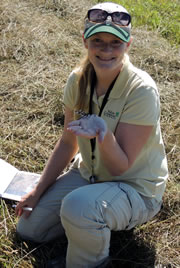Tales from the pond - Part 1
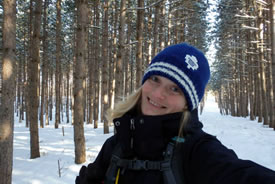
Kristyn Ferguson out for a snowy day of field work (Photo by NCC)
At a property owned by the Nature Conservancy of Canada (NCC) in the Georgian Bay–Huronia sub-region, a beautiful stream courses through a deciduous forest, providing excellent habitat for coldwater fish species including brown trout, and for many species of aquatic plants and animals.
Emerging from the forest, the stream suddenly smacks straight into something that is at once both beautiful, and troubling. A large, deep pond, whose waters ripple lightly in the breeze. While gorgeous to look at, this pond is actually a manmade creation. Back in the mid-1900s, the natural stream course was altered by the construction of a dam, the installation of an outflow structure and culvert, and digging of a pond base, which caused the water to back up, pool, and form a pond.
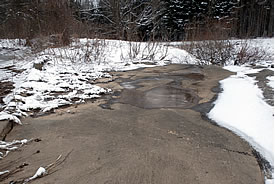
Concrete pad at base of dam (Photo by NCC)
Because of the addition of this infrastructure, fish were no longer were able to pass through to their downstream habitat. Unoaccustomed to warmer temperatures and unable to survive in them as the pond warmed, the fish quickly retreated upstream. A few squatters took advantage of this vacancy and moved into the pond: namely blue-green algae and an invasive aquatic plant called milfoil, causing issues for downstream water quality and further decreasing the water quality in the pond area.
When NCC took over ownership and management of the property, we realized that something beautiful had turned into something less than lovely and it was time to restore and reconnect the natural stream channel. This work is planned for late 2014; which meant that as soon as the first rays of spring shone through, after the world’s longest winter, it was time for me to get to work!
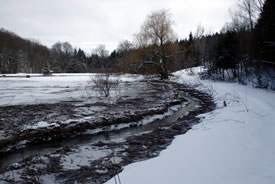
Stream on property, ON (Photo by NCC)
It is extremely important to understand the site conditions of the stream and pond in spring, when thawing snow and increasing rainfalls can exact immense pressure on aquatic systems. NCC, working closely with an engineering firm overseeing the project, will need to understand exactly what we’re up against so we can design a channel that will support the natural flow regime of the system.
So a few weeks ago in early April, armed with my depth meter, oranges (a somewhat “novice” way of measuring waterflow in a channel, but it's a lot of fun tossing oranges into a river), camera and measuring tape, I headed out to Creemore on a promisingly sunny six-degree day in early April. When planning the site visit, I had pictured myself dabbling at the edges of the pond in my rubber boots, kneeling in the muck over top of the culvert to measure the height of flowing water and making sure to reapply sunscreen frequently!
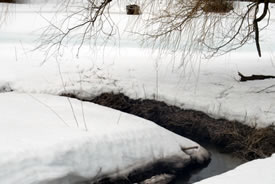
Spring stream monitoring (Photo by NCC)
Apparently I believed that two or three days days of above-zero temperatures meant that spring was here — full fledged, no holds barred... spring! Needless to say, I was in for quite a surprise when I stepped onto the forest trail that leads to the pond to find my rubber boot clad foot sink two feet into a snow drift.
I was unphazed, even as tiny crystals of wet snow slunk into the boot and were absorbed by my sock. I slogged my way through intermittently packed (read: easy walking) and loose (read: easy sinking) snow drifts along the trail, finally arriving at the stream/pond interface...Only to find the stream still completely frozen over!
I vetoed my first monitoring location and moved to the second: an area where the stream flows underneath a constructed trail just above the pond. However, as ice actively crashed into the area below the culvert and I couldn’t tell where the bank ended and snow started, I wisely hung back lest I be the next thing to go crashing down.
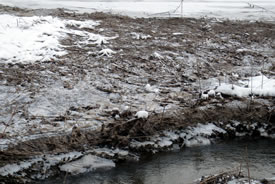
Frozen riverbank (Photo by NCC)
A bit concerned, I started my walk to the pond itself. Along the way I managed to lose both my rubber boots to the snow and soak both my socks thoroughly. I spent a full minute trying to extract one boot that I thought might, indeed, be lost forever in the hip-deep snow. I can’t confirm or deny whether after getting through this particularly tough spot I noticed that I’d left my pen back at the trail/stream crossing — that one is between me and the black-capped chickadees that taunted me in a spring-like fashion with their mating call of “cheeeeeeeseburger!” from the forest trees.
My frozen day continued with another section of frozen stream, a completely frozen pond and a downstream flow that was inaccessible due to high banks of unpredictably deep snow. Let’s just say I did some excellent photo monitoring that day, and not much else!
Resigned to the fact that spring was still not quite here, I left the site and marched to my car with a backpack full of oranges and my return planned in two weeks. After some 20-degree temperatures here in Ontario I’m sure things will be a bit more actively splashing and flowing upon my next visit, though time will only tell what my next monitoring visit will have in store!

